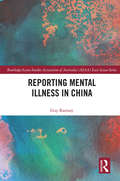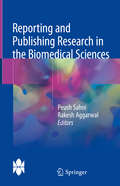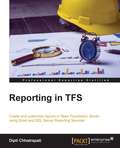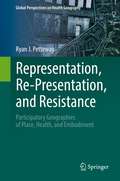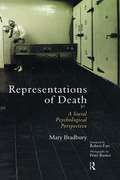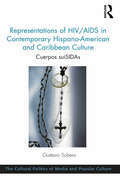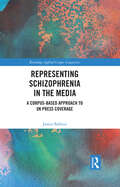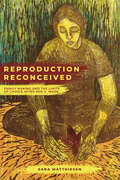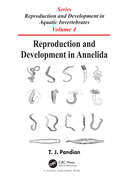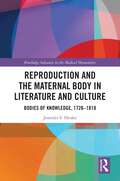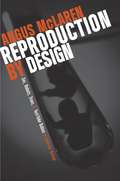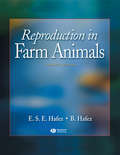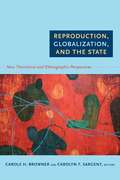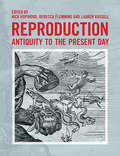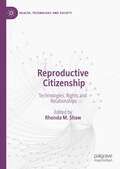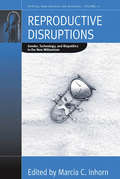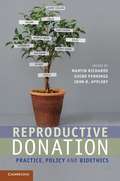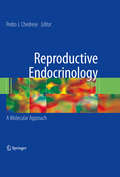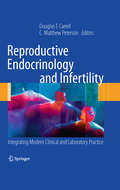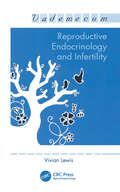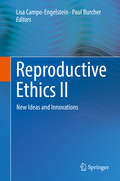- Table View
- List View
Reporting Mental Illness in China (Routledge/Asian Studies Association of Australia (ASAA) East Asian Series)
by Guy RamsayThis book examines how Chinese-language newspapers across greater China report on severe mental illness, and why they do so in the ways they do, given that reporting in local newspapers can strongly influence how Chinese readers view the illness. By assessing how the reporting in three leading broadsheet newspapers from mainland China, Hong Kong, and Taiwan constructs the illness, the book considers how the distinct social and political histories of the three culturally Chinese communities shape the reporting, and whether it bears out or contests the intense stigma against the illness that prevails locally. The findings can usefully encourage and inform attempts to humanise, include, and empower those with a severe mental illness across greater China and the global Chinese diaspora. Employing a well-tested, transparent discourse analytic approach, the book also includes numerous Chinese-English bilingual news report extracts to illustrate its claims. As such, Reporting Mental Illness in China will be of interest to sinologists, discourse analysts, mental health professionals and public health authorities across the globe, especially in places where there are large Chinese-speaking populations.
Reporting and Publishing Research in the Biomedical Sciences: Revised Edition
by Peush Sahni Rakesh AggarwalThis book eases the task of converting research work into a manuscript, and covers the recent developments in publishing that often stump budding researchers.Few researchers in the biomedical sciences are trained in the essential skills of reporting their results, and they seek help in writing a paper that will be acceptable for publication in the ‘right’ journal, and in presenting their results ‘effectively’ at a meeting. As well as covering the basic aspects of preparing manuscripts for publication, the book discusses best practices and issues relating to the publication of biomedical research, including topics such as peer-review, authorship, plagiarism, conflicts of interest, publication misconduct, electronic publishing and open-access journals. With more than two decades of experience in conducting workshops on writing scientific papers, the editors have brought together the expertise of 29 authors from seven countries to produce this one-stop guide to publishing research in biomedical sciences. This book is intended for young researchers who are beginning their careers and wish to hone their skills and understand the rigors of research writing and publishing.
Reporting for Duty: True Stories of Wounded Veterans and Their Service Dogs
by Tracy J. LibbyInspirational accounts of veterans who have moved forward from mental and physical injuries toward healthier lives with the help of service dogs. Hundreds of thousands of military veterans seek treatment for post-traumatic stress disorder (PTSD) each year. Service dogs have been used for many years in the civilian sector to help their disabled owners perform necessary tasks in daily life; likewise, the organized use of therapy dogs to bring comfort and companionship to hospital and nursing-home patients dates back more than four decades. Reporting for Duty explores the unique and special bond between wounded warriors—especially those suffering from PTSD—and their service dogs and discusses the vital work of therapy dogs who visit VA hospitals and military rehabilitation facilities. Author Tracy Libby tells the true stories of disabled veterans who have been touched, assisted, and enriched by the dogs in their lives, and the new lease on life is reciprocal: many of these service and therapy dogs have been rescued from shelters and specially trained for their jobs. A portion of proceeds from the sale of this book will benefit a veterans&’ service-dog organization.Inside Reporting for Duty . . .True stories of physically and mentally disabled veterans who count on service dogs for assistance with daily tasksAn explanation of PTSD and how it affects military veteransHow therapy dogs and service dogs are selected and trained for their jobsRescuing shelter dogs to train for therapy and service workHow the military is training dogs to accompany soldiers on deploymentsA look at the bond between people and dogs and the positive effects it has on both
Reporting in TFS
by Dipti ChhatrapatiThis book is intended for developers, testers, architects, and project managers who want to explore and make use of the reporting facilities of Team Foundation Server 2013. Although no previous experience of reporting is required, a basic understanding of the Team Foundation Components and project templates would be a plus.
Representation, Re-Presentation, and Resistance: Participatory Geographies of Place, Health, and Embodiment (Global Perspectives on Health Geography)
by Ryan J. PettewayThis book draws on the author's ten years of participatory work to examine core themes of (mis)representation, re-presentation, and resistance within place-health research and practice. The book includes practice- and research-based projects with implications and applications for practitioners (e.g. local health department epidemiologists) and academics, introducing readers to an array of new and mixed-methods within place-health research. It also introduces new conceptual and analytical place-health frameworks that more explicitly account for power—both within place making, unmaking, and remaking processes, and within the (re)production of place-health knowledges. Across six chapters, the author reports and reflects on a selection of research projects, raising key considerations in regard to place-health (mis)representation, and highlighting the value of participatory methods and processes in re-presenting—and decolonizing—spatial narratives of health. This includes an emphasis on the integration of community-based participatory research (CBPR) principles with the technological and procedural affordances of information and communication technologies (ICTs). With each chapter drawing from CBPR, decolonizing, social epidemiology, health geography, Black feminist, and critical theory orientations, the book offers an integrated call and framing for a critical examination of how geographies of “place” and health—and narratives/stories therein—are constructed, and perhaps might be de/re-constructed through inclusive and equitable research practices that center community and offer a mode of resistance for the production of place-health counternarratives. The book is intended for academic researchers and practitioners in public health and health geography fields, particularly those whose work engages social epidemiology, urban planning, and aspects of community development, and will also appeal to researchers and practitioners who use participatory, community-inclusive methods and processes in their work, especially as related to community mapping.
Representations of Death: A Social Psychological Perspective
by Mary BradburyDrawing upon a rare and highly original ethnography of contemporary mortuary practices, Representations of Death takes the reader through the medical, bureaucratic, commercial and ritual aspects of death Going behind the scenes at hospitals, funeral parlours, crematoria and cemeteries, as well as holding poignant, in-depth interviews with bereaved women, Bradbury has been able to illuminate the very different perspectives of the deathwork professional and the grieving relative. Illustrated with stunning photographs, this fascinating book makes a significant contribution to the growing literature in death studies.
Representations of HIV/AIDS in Contemporary Hispano-American and Caribbean Culture: Cuerpos suiSIDAs (The\cultural Politics Of Media And Popular Culture Ser.)
by Gustavo SuberoExploring the mechanisms and strategies used in different cultures across Hispano-America and the Caribbean to narrativise, represent and understand HIV/AIDS as a social and human phenomenon, this book examines a wide range of cultural, artistic and media texts, as well as issues of human phenomenology, to understand the ways in which HIV positive individuals make sense of their own lives, and of the ways in which the rest of society sees them. Drawing on a variety of cultural texts from cinema, television, photography and literature, the author considers the manner in which contemporary cultural forms have shaped a body of public opinion in response to the social and cultural impact of HIV/AIDS, re-interpreting the condition in the light of advances in treatment. With attention to both the temporality and spatiality of production, this book examines whether heterosexual and homosexual, and masculine and feminine bodies are narrativised in the same manner, considering the question of whether representations foster discrimination of any kind. The book also asks whether representations across Latin America are homogenous or varied according to national, social or cultural context, and explores the commonalities between the representations of HIV/AIDS in Hispano-America and the Caribbean and other global narratives. A detailed study of the various representations of HIV/AIDS and the construction of public opinion, this book will appeal to scholars of cultural, media and film studies, the sociology of health, the body and illness, and Latin American and Caribbean Studies.
Representing Schizophrenia in the Media: A Corpus-Based Approach to UK Press Coverage (Routledge Applied Corpus Linguistics)
by James BalfourThis book presents a critical analysis of ways in which schizophrenia and people with schizophrenia are represented in the press. Interrogating a 15-million-word corpus of news articles published by nine UK national newspapers over a 15-year period, the author draws on techniques from corpus linguistics and critical discourse analysis to identify the most frequent and salient linguistic features used by journalists to influence and reflect broader public attitudes towards people with schizophrenia. In doing so this book: Evaluates the extent to which media representations are accurate and the extent to which they are potentially helpful or harmful towards people living with schizophrenia; Employs a bottom-up approach guided by linguistic patterns, such as collocates and keywords, identified by corpus software; Contributes to the de-stigmatisation of schizophrenic disorder by unveiling some of the widespread misconceptions surrounding it; Applies a mixed-methods approach in order to expose attitudes and beliefs found ‘between the lines’ – values and assumptions which are often implicit in the way language is used and therefore not visible to the naked eye. The findings of this monograph will be relevant to advanced students and researchers of health communication, corpus linguistics and applied linguistics and will also carry importance for journalists and mental health practitioners.
Reproduction Reconceived: Family Making and the Limits of Choice after Roe v. Wade (Reproductive Justice: A New Vision for the 21st Century #5)
by Sara MatthiesenThe landmark case Roe v. Wade redefined family: it is now commonplace for Americans to treat having children as a choice. But the historic decision also coincided with widening inequality, an ongoing trend that continues to make choice more myth than reality. In this new and timely history, Matthiesen shows how the effects of incarceration, for-profit healthcare, disease, and poverty have been worsened by state neglect, forcing most to work harder to maintain a family.
Reproduction and Adaptation
by C. G. Mascie-Taylor Lyliane RosettaIn the space of one generation major changes have begun to take place in the field of human reproduction. A rapid increase in the control of fertility and the understanding and treatment of sexual health issues have been accompanied by an emerging threat to reproductive function linked to increasing environmental pollution and dramatic changes in lifestyle. Organised around four key themes, this book provides a valuable review of some of the most important recent findings in human reproductive ecology. Major topics include the impact of the environment on reproduction, the role of physical activity and energetics in regulating reproduction, sexual maturation and ovulation assessment and demographic, health and family planning issues. Both theoretical and practical issues are covered, including the evolution and importance of the menopause and the various statistical methods by which researchers can analyse characteristics of the menstrual cycle in field studies.
Reproduction and Development in Annelida (Reproduction and Development in Aquatic Invertebrates)
by T. J. PandianThis book is a concise informative elucidation of all aspects of reproduction and development in annelids covering from arenicola to tubifex. Annelids flourish between 4,900 m depth to 2,000 m altitude; some of them occur in unusual habitats like hydrothermal vents and subterranean aquatic system (stigobionts). A few have no gut and acquire adequate nutrients through osmotrophism and/or engaging symbiotic microbes. In the absence of exoskeleton to escape predation, the 17,000 speciose annelids have explored bewildering modes of reproduction; not surprisingly, 42–47% of them are brooders. With 13,000 species, polychaetes are gonochores but some 207 species of them are hermaphrodites. Clitellates are all hermaphrodites; of them, 76 species are parthenogens, of which 56 are earthworms. Regenerative potency of annelids ranges from an organ to an entire worm from a single ‘seminal’ segment. The head, tail and both together can be regenerated 21, 42 and 20 times, respectively. However, the potency is limited to ~1% of polychaetes and Heterogamatic sex determination is reported to occur only in six polychaete species, although karyotype is known for 83 annelid species. In temperate polychaetes, a dozen neuroendocrines, arising mostly from the ‘brain’ regulates reproductive cycle. A complete chapter devoted to vermiculture, (i) recognizes the fast-growing candidate species, (ii) distinguishes 'layers' from 'brooders', (iii) indicates that the harvest of oligochaetes may reduce the input of nitrogenous fertilizer in the ricefield, and (iv) explores the scope for increasing wealth from waste.
Reproduction and the Maternal Body in Literature and Culture: Bodies of Knowledge, 1726-1818 (Routledge Advances in the Medical Humanities)
by Jennifer S. HenkeThis book examines a selection of texts to discuss how midwifery, obstetrics and women’s bodies were constructed during the (long) eighteenth century, and how these material-discursive entanglements between science, medicine, literature and culture have shaped society's views of pregnancy, childbirth and reproduction.Drawing on theories from disciplines such as feminist new materialism, this book traces the history of both the reproductive body and the pluralistic medical knowledges that attended to pregnancy and childbirth during the Enlightenment and early Romanticism in Britain. It identifies the significance of literary and cultural artefacts in this knowledge formation, including the materiality of the female reproductive body itself, and raises awareness of myths about pregnancy and childbirth that persist today. This book features chapters exploring Jonathan Swift’s Gulliver’s Travels, John Cleland’s Fanny Hill, Laurence Sterne’s Tristram Shandy, Eliza Fenwick’s Secresy, Or: The Ruin on the Rock, Mary Wollstonecraft’s Maria, Or: The Wrongs of Woman, and Mary Shelley’s Frankenstein.Reproduction and the Maternal Body in Literature and Culture is an innovative and interdisciplinary contribution to the medical humanities and feminist philosophy of science and will interest scholars from a range of backgrounds, including literature and cultural studies, midwifery, medicine and history.
Reproduction by Design: Sex, Robots, Trees, and Test-Tube Babies in Interwar Britain
by Angus MclarenModernity in interwar Europe frequently took the form of a preoccupation with mechanizing the natural; fears and fantasies revolved around the notion that the boundaries between people and machines were collapsing. Reproduction in particular became a battleground for those debating the merits of the modern world. That debate continues today, and to understand the history of our anxieties about modernity, we can have no better guide than Angus McLaren. In Reproduction by Design, McLaren draws on novels, plays, science fiction, and films of the 1920s and '30s, as well as the work of biologists, psychiatrists, and sexologists, to reveal surprisingly early debates on many of the same questions that shape the conversation today: homosexuality, recreational sex, contraception, abortion, euthanasia, sex change operations, and in vitro fertilization. Here, McLaren brings together the experience and perception of modernity with sexuality, technology, and ecological concerns into a cogent discussion of science's place in reproduction in British and American cultural history.
Reproduction in Farm Animals
by B. Hafez E.S.E. HafezWhen you’re looking for a comprehensive and reliable text on large animal reproduction, look no further! the seventh edition of this classic text is geared for the undergraduate student in Agricultural Sciences and Veterinary Medicine. In response to reader feedback, Dr. Hafez has streamlined and edited the entire text to remove all repetitious and nonessential material. That means you'll learn more in fewer pages. Plus the seventh editing is filled with features that help you grasp the concepts of reproduction in farm animals so you'll perform better on exams and in practice: condensed and simplified tables, so they're easier to consult an easy-to-scan glossary at the end of the book an expanded appendix, which includes graphic illustrations of assisted reproduction technology Plus, you'll find valuable NEW COVERAGE on all these topics: Equine Reproduction: expanded information reflecting today's knowledge Llamas (NEW CHAPTER) Micromanipulation of Gametes and In Vitro Fertilization (NEW CHAPTER!) Reach for the text that's revised with the undergraduate in mind: the seventh edition of Hafez's Reproduction in Farm Animals.
Reproduction in Transgender and Nonbinary Individuals: A Clinical Guide
by Molly B. Moravek Gene De Haan<p>There are approximately 1.4 million trans-identified individuals in the US alone, many of whom will undergo gender-affirming medical or surgical interventions to better align their appearance with their gender identity. Multiple major medical societies recommend fertility preservation counseling prior to starting any gender-affirming therapies, but data are limited on the reproductive effects of common gender-affirming hormone regimens. The burden of fertility counseling falls to the hormone providers and surgeons that are encountering these patients, many of whom will not have had adequate training or resources to provide evidence-based recommendations and options. Additionally, many reproductive health care providers are not trained in how to care for gender minorities.<p> <p>The purpose of this book is to be a reference for clinicians and researchers in the field of transgender medicine, to provide up-to-date data and resources to properly counsel transgender and nonbinary patients about the reproductive consequences of gender-affirming interventions and their options for family-building, and to educate providers about appropriate and culturally competent reproductive health care. Effects of masculinizing and feminizing hormone therapy, as well as the fertility preservation options available, are discussed in detail for both adults and youth. In addition to these medical considerations, both psychosocial, legal and ethical considerations are highlighted for a more well-rounded presentation. A final chapter describes how to create a welcome and accepting clinical environment.<p> <p>Such a reference does not currently exist, leading to the propagation of misinformation and encouraging patients to seek nonmedical sources, such as social media, for their information. Reproduction in Transgender and Nonbinary Individuals fills in this gap as a timely text for reproductive endocrinologists, surgeons and all clinical staff working with this population.<p>
Reproduction, Globalization, and the State: New Theoretical and Ethnographic Perspectives
by Carole H. Browner Carolyn F. SargentReproduction, Globalization, and the State conceptualizes and puts into practice a global anthropology of reproduction and reproductive health. Leading anthropologists offer new perspectives on how transnational migration and global flows of communications, commodities, and biotechnologies affect the reproductive lives of women and men in diverse societies throughout the world. Based on research in Africa, the Americas, Asia, and Western Europe, their fascinating ethnographies provide insight into reproduction and reproductive health broadly conceived to encompass population control, HIV/AIDS, assisted reproductive technologies, paternity tests, sex work, and humanitarian assistance. The contributors address the methodological challenges of research on globalization, including ways of combining fine-grained ethnography with analyses of large-scale political, economic, and ideological forces. Their essays reveal complex interactions among global and state population policies and politics; public health, human rights, and feminist movements; diverse medical systems; various religious practices, doctrines, and institutions; and intimate relationships and individual aspirations. Contributors. Aditya Bharadwaj, Caroline H. Bledsoe, Carole H. Browner, Junjie Chen, Aimee R. Eden, Susan L. Erikson, Didier Fassin, Claudia Lee Williams Fonseca, Ellen Gruenbaum, Matthew Gutmann, Marcia C. Inhorn, Mark B. Padilla, Rayna Rapp, Lisa Ann Richey, Carolyn Sargent, Papa Sow, Cecilia Van Hollen, Linda Whiteford
Reproduction: Antiquity to the Present Day
by Nick Hopwood Rebecca Flemming Lauren KassellFrom contraception to cloning and pregnancy to populations, reproduction presents urgent challenges today. This field-defining history synthesizes a vast amount of scholarship to take the long view. Spanning from antiquity to the present day, the book focuses on the Mediterranean, western Europe, North America and their empires. It combines history of science, technology and medicine with social, cultural and demographic accounts. Ranging from the most intimate experiences to planetary policy, it tells new stories and revises received ideas. An international team of scholars asks how modern 'reproduction' - an abstract process of perpetuating living organisms - replaced the old 'generation' - the active making of humans and beasts, plants and even minerals. Striking illustrations invite readers to explore artefacts, from an ancient Egyptian fertility figurine to the announcement of the first test-tube baby. Authoritative and accessible, Reproduction offers students and non-specialists an essential starting point and sets fresh agendas for research.
Reproductive Biology and Early Life History of Fishes in the Ohio River Drainage: Ictaluridae - Catfish and Madtoms, Volume 3
by Thomas P. Simon Robert WallusThis series fills immense gaps in knowledge of issues related to early life development of fishes in the Ohio basin. Volume III addresses the developmental and morphological issues of catfish and madtoms. This volume describes the characteristics of the Ictaluridae family, and provides a detailed pictorial guide. Subtopics within each species description includes range, distribution, occurrence, spawning, eggs, development, ecology of early life phases, and more. This book serves as both a guide to help identify individual larval fish and as a reference for environmental managers concerned with the overall health of the ecosystem that they are monitoring.
Reproductive Citizenship: Technologies, Rights and Relationships (Health, Technology and Society)
by Rhonda M. ShawThis book addresses responses to the predicament of medical and social infertility. It draws on international research to examine the dimensions of reproductive citizenship in relation to decision-making about a range of issues: from fertility preservation and the desirability of family creation as a normative expectation of social participation, to how families manage and negotiate engagement with providers of reproductive materials and services around information disclosure and contact, and how they consider their social obligations and responsibilities in relation to the use of assisted reproductive technology (ART).
Reproductive Disruptions
by Marcia C. InhornNominated for the 2007 Book Prize by the Council on Anthropology and Reproduction (AAA) Reproductive disruptions, such as infertility, pregnancy loss, adoption, and childhood disability, are among the most distressing experiences in people's lives. Based on research by leading medical anthropologists from around the world, this book examines such issues as local practices detrimental to safe pregnancy and birth; conflicting reproductive goals between women and men; miscommunications between pregnant women and their genetic counselors; cultural anxieties over gamete donation and adoption; the contested meanings of abortion; cultural critiques of hormone replacement therapy; and the globalization of new pharmaceutical and assisted reproductive technologies. This breadth - with its explicit move from the "local" to the "global," from the realm of everyday reproductive practice to international programs and policies - illuminates most effectively the workings of power, the tensions between women's and men's reproductive agency, and various cultural and structural inequalities in reproductive health.
Reproductive Donation
by Martin Richards Guido Pennings John B. ApplebyReproductive donation is the most contentious area of assisted reproduction. Even within Europe there are wide variations in what is permitted in each country. This multidisciplinary book takes a fresh look at the practices of egg, sperm and embryo donation and surrogacy, bringing together ethical analysis and empirical research. New evidence is offered on aspects of assisted reproduction and the families these create, including non-traditional types. One of the key issues addressed is should children be told of their donor origin? If they do learn the identity of their donor, what kinds of relationships may be forged between families, the donor and other donor sibling families? Should donation involve a gift relationship? Is intra-familial donation too close for comfort? How should we understand the growing trend for 'reproductive tourism'? This lively and informed discussion offers new insights into reproductive donation and the resulting donor families.
Reproductive Endocrinology
by P. Jorge ChedreseMolecular biology emerged from advances in biochemistry during the 1940s and 1950s, when the structure of the nucleic acids and proteins were elucidated. Beginning in the 1970s, with nucleic acid enzymology and the discovery of the restriction enzymes, the tools of molecular biology became widely available and applied in cell biology to study how genes are regulated. This new knowledge impacted endocrinology and reproductive biology since it was largely known that the secretion of the internal glands affected the phenotypes, and expression of genes. Modern reproductive biology encompasses every level of biological study from genomics to ecology, encompassing cell biology, biochemistry, endocrinology and general physiology. All of these disciplines require a basic knowledge, both as a tool and as an essential aid to a fundamental understanding of the principles of life in health and disease. Overall, molecular biology is central to scientific studies in all living matter, impacting disciplines such as medicine, related health sciences, veterinary, agriculture and environmental sciences. In this book, the basic biochemistry of nucleic acids and proteins are reviewed. Methodologies used to study signaling and gene regulation in the endocrine/reproductive system are also discussed. Topics include mechanisms of hormone action and several endocrine disorders affecting the reproductive system. Professionals in the medical, veterinary and animal sciences fields will find exciting and stimulating material enhancing the breadth and quality of their research.
Reproductive Endocrinology and Infertility
by Douglas T. Carrell C. Matthew PetersonManagement of the modern reproductive endocrinology and infertility clinic has become very complex. In addition to the medical and scientific aspects, it is crucial that the modern director be aware of of incongruent fields such as marketing, accounting, management, and regulatory issues. Reproductive Endocrinology and Infertility: Integrating Modern Clinical and Laboratory Practice was developed to assist the practicing reproductive endocrinologist and/or laboratory director by providing an overview of relevant scientific, medical, and management issues in a single volume. Experts in all pertinent areas present concise, practical, evidence-based summaries of relevant topics, producing a key resource for physicians and scientists engaged in this exciting field of medicine. As novel technologies continue to amplify, Reproductive Endocrinology and Infertility: Integrating Modern Clinical and Laboratory Practice offers insight into development, and imparts extra confidence to practitioners in handling the many demands presented by their work.
Reproductive Endocrinology and Infertility
by Dr. Vivian LewisReproductive Endocrinology and Infertility provides an overview of the most frequently encountered clinical challenges faced by medical students and residents. Part I begins with chapters on reproductive hormonal physiology and development to provide a basis for understanding the management of the most common reproductive clinical problems that confront obstetrician-gynecologists and other practitioners in women’s health. Several of the chapters, including obesity, premenstrual syndrome, menopause and imaging, provide a cross-disciplinary approach to endocrine related problems common among reproductive aged women. Part II includes chapters on the evaluation of infertility, as well as surgical and medical approaches to treating infertility in men and women. The chapter on alternative medicine provides a basis for understanding the increasingly popular use of therapies such as acupuncture and herbal treatments. The last chapter discusses the influence of environmental factors on fertility, an important field that is often ignored in the traditional approach to infertility.This text is meant to be used as a portable reference with readily accessible information including a summary of key points in each chapter. All of the contributors are involved in residency training programs and understand the kinds of patient management questions that are encountered in a busy practice. Our goal with this book is to provide information that will support solid patient management and hopefully pique the appetite to learn more.
Reproductive Ethics II: New Ideas and Innovations
by Lisa Campo-Engelstein Paul BurcherThis book is the second collection of essays on reproductive ethics from Drs. Campo-Engelstein and Burcher. This volume is unique in that it is both timely and includes several essays on new technologies, while also being a comprehensive review of most of the major questions in the field, from racial disparities in reproductive healthcare to gene editing and the possibility of the creation of a transhuman species. The scholars writing these essays are pre-eminent in their fields, and their backgrounds are quite varied, including philosophers, anthropologists, physicians, and professors of law. Reproductive ethics remains an underdeveloped area of bioethics despite the recent technological breakthroughs that carry both great promise and potential threats. Building on the first volume of work from a conference held just over one year ago, this new collection of essays from a conference held April 2017 continues this discussion as well as provides ethical insights and reviews of these emerging technologies. The ethical questions swirling around human reproduction are both old and new, but the conference presentations, and the essays derived from them, focus on new ways of appreciating old arguments such as the ethics of abortion, as well as new ways of seeing new technologies such as CRISPR and mitochondrial transfer.
